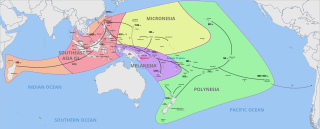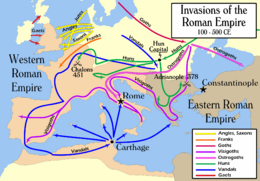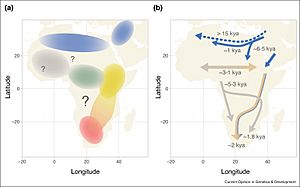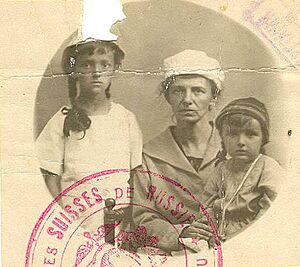History of human migration facts for kids
Human migration is when people move from one place to another, often to a different country. They might plan to stay for a short time or forever. This usually means traveling long distances, like from one country or area to another. The number of people who move can change a lot, depending on why they are moving.
Long ago, early humans moved to new parts of the world where no one had lived before. This happened during the Upper Paleolithic period, also known as the Late Stone Age. Later, most migrations involved groups expanding into new lands or even colonizing them. In more recent times, people mostly move within their own countries or between different countries. This can be done legally (legal immigration) or without permission (illegal immigration).
People can move because they choose to (voluntary migration) or because they are forced to (involuntary migration). Being forced to move can happen in many ways. This includes being sent away (deportation), being part of the slave trade, or having to flee from wars (war refugees) or ethnic cleansing. When large groups of people are forced to leave their homes, they can form a diaspora, which means they live scattered far from their original homeland.
Contents
Early Human Journeys
Studies show that the first big human movements began about 1.75 million years ago. That's when Homo erectus moved out of Africa and spread across Eurasia. Our own species, Homo sapiens, lived all over Africa about 150,000 years ago. Some of these early humans started moving out of Africa around 70,000 years ago.
Most people living outside Africa today are thought to come from a later migration. This happened between 70,000 and 50,000 years ago. These groups spread across Australia, Asia, and Europe by 40,000 BCE. People arrived in the Americas between 20,000 and 15,000 years ago.
By 2,000 years ago, humans had settled most of the Pacific Islands. Big population movements also happened with the Neolithic Revolution, which was when farming began. Another major movement was the spread of Indo-European people. The Great Migrations in the Early Middle Ages, including Turkic expansion, also left important marks.
In some places, like Turkey and Azerbaijan, cultures changed a lot after smaller groups of powerful people moved in. Historians compare this to the Roman and Norman takeovers of Britain. The big change from Roman Britain to Anglo-Saxon Britain might be due to many Anglo-Saxons moving there.
Early humans moved for many reasons. These included changes in climate and landscape, or not enough food for everyone. The ancestors of the Austronesian peoples are believed to have spread from southern China to the island of Taiwan about 8,000 years ago.

Evidence from studying languages suggests that seafaring people moved from Taiwan. They traveled in waves over thousands of years, spreading across the entire area where Austronesian languages are spoken. This migration is thought to have started around 6,000 years ago.
The Indo-Aryan migration from the Indus Valley to the Ganges River plain in Northern India likely happened in the Middle to Late Bronze Age (around 1700 to 1300 BCE). From 180 BCE, several invasions from Central Asia happened in northwestern India. These included groups like the Indo-Greeks and Kushans.
From 728 BCE, the Greeks began 250 years of expansion. They set up colonies in many places, including Sicily and Marseille. In ancient Europe, two main migration movements happened. First, the Celtic peoples spread in the first millennium BCE. Later, the Migration Period in the first millennium CE saw people move from the North and East.
A smaller migration involved the Magyars moving into Pannonia (modern-day Hungary) in the 9th century CE. Turkic peoples spread from their homeland in modern Turkestan across much of Central Asia into Europe and the Middle East. This happened between the 6th and 11th centuries CE.

Recent studies suggest that Madagascar was empty until Austronesian sailors from present-day Indonesia arrived in the 5th and 6th centuries CE. Later migrations from both the Pacific and Africa mixed with these original settlers, forming the Malagasy people.
Before the Bantu languages and their speakers spread, the southern half of Africa was likely home to Pygmies and Khoisan-speaking people. Their descendants now live in the dry areas around the Kalahari Desert and the forests of Central Africa. By about 1000 CE, Bantu migration had reached modern-day Zimbabwe and South Africa.
The Banu Hilal and Banu Ma'qil, Arab Bedouin tribes, moved west from the Arabian Peninsula through Egypt between the 11th and 13th centuries. Their movement greatly helped spread Arab culture and Islam in the western Maghreb, which was mostly Berber before then. Ostsiedlung was a medieval movement of Germans eastward. They followed in the footsteps of East Germanic Goths and North Germanic Varangians. The 13th century saw huge Mongol and Turkic migrations across Eurasia. The Eurasian steppe has often been a path for groups like Huns, Bulgars, Tatars, and Slavs.
Between the 11th and 18th centuries, many migrations happened in Asia. The Vietnamese started expanding southward in the 11th century, a movement known as nam tiến (southward expansion). The early Qing dynasty (1644-1912) kept Manchuria separate from China proper. This stopped Han Chinese from moving into Manchuria until the late 18th century, when the Qing began to settle them there.
The Age of Exploration and European colonialism sped up migration from early modern times. In the 16th century, about 240,000 Europeans arrived in American ports. In the 19th century, over 50 million people left Europe just for the Americas. Local populations, like the Aboriginal people in Canada, Brazil, Australia, and the United States, were often outnumbered by new settlers and their indentured laborers and imported slaves.
Modern Migration Trends
Migration sped up even more in the 19th century. There were three main types of migration: people moving for work, people moving as refugees, and people moving to cities (urbanization). Millions of farm workers left the countryside for cities, leading to huge growth in urban areas. This started in Britain in the late 1700s and continues today in many parts of the world.
Impact of Industrialization
Industrialization encouraged migration everywhere it happened. The world economy became more connected, and so did the job market. The Atlantic slave trade greatly reduced after 1820. This led to more people from Europe and Asia moving to plantations as contract laborers. Overcrowding, new farming lands, and growing industrial cities attracted people who wanted to move. Also, better transportation made it much easier to travel.
In the 19th century, Romantic nationalism also grew, along with ethnocentrism, which is when people think their own group is the best. The big European industrial empires also rose. Both of these things affected migration. Some countries preferred their own people, while others seemed more welcoming. For example, the Russian Empire favored Eastern Orthodoxy, and Jewish people were restricted to the Pale of Settlement. They also faced violence. The United States was seen as a better place, a "golden land" where Jewish people could live more freely.
Another effect of imperialism was colonialism. This led to people moving from "home countries" to "colonies," and later, people moving from "colonies" to "home countries."
Moving for work across countries reached a peak of three million migrants per year in the early 1900s. Italy, Norway, Ireland, and the Guangdong region of China had very high rates of people leaving during these years. These large movements of people shaped how nations formed. Countries developed immigration restrictions. Also, diaspora cultures and stories grew, showing how important migration was to the founding of some nations, like the American melting pot. Transnational labor migration slowed down from the 1930s to the 1960s, then increased again.
The United States also saw a lot of internal migration due to industrialization, especially among its African American population. From 1910 to 1970, about 7 million African Americans moved from the rural Southern United States. In the South, black people faced poor job opportunities and much prejudice. They moved to industrial cities in the Northeast, Midwest, and West, where better-paying jobs were available. This was called the Great Migration in the United States. Historians now see it as two main phases.
The first phase ended around the time of the Great Depression. The second phase, from World War II to 1970, is called the Second Great Migration. After legal segregation ended in the 1960s and job opportunities improved in the South, millions of black people have moved back to the South since 1980. This is known as the New Great Migration.
World Wars and Their Aftermath
The First and Second World Wars, and the conflicts they caused, had a huge impact on migration. During the fall of the Ottoman Empire, Muslims moved from the Balkans to Turkey, and Christians moved the other way. Four hundred thousand Jewish people had already moved to Palestine in the early 1900s, and many to America. The Russian Civil War caused about three million Russians, Poles, and Germans to leave the new Soviet Union. Decolonization after World War II also led to migrations.
Jewish communities across Europe, the Mediterranean, and the Middle East were formed by people who moved voluntarily or were forced to move. After the Holocaust (1938-1945), more Jewish people moved to the British Mandate of Palestine. This area became the modern state of Israel after the United Nations Partition Plan for Palestine.
The Potsdam Agreement in 1945, signed by the victorious Western Allies and the Soviet Union, led to one of the largest migrations in Europe, and the biggest in the 20th century. Close to or over 20 million people moved and resettled. The largest group affected were 16.5 million Germans expelled from Eastern Europe westward. The second largest group were Poles. Millions of Poles were expelled westward from the eastern Kresy region and resettled in the so-called Recovered Territories.
Hundreds of thousands of Poles, Ukrainians (Operation Vistula), Lithuanians, Latvians, Estonians, and some Belarusians were sent eastward to the Soviet Union. Finally, many of the several hundred thousand Jewish people remaining in Eastern Europe after the Holocaust migrated outside Europe to Israel and the United States.
Partition of India
In 1947, when India was divided, huge populations moved between India and Pakistan based on their religious beliefs. This division was created by the Indian Independence Act 1947 as the British Indian Empire ended. The partition displaced up to 17 million people. Estimates of lives lost range from several hundred thousand to a million. Muslim residents of former British India moved to Pakistan (including East Pakistan, now Bangladesh). Meanwhile, Hindu and Sikh residents of Pakistan, and Hindu residents of East Pakistan, moved the other way.
In modern India, estimates suggest there are about 100 million circular migrants. These are people who move back and forth for work. Social networks and past events play a big role in shaping these migration patterns.
Research shows a fast movement of workers from slower-growing parts of the economy to faster-growing ones. Migrants can sometimes be left out by city housing rules. Support programs are needed to help workers get better access to job information, identity papers, housing, and education.
In the conflicts before the partition in the Punjab region, between 200,000 and 500,000 people were killed in violence. U.N.H.C.R. estimates 14 million Hindus, Sikhs, and Muslims were displaced during the partition. Scholars call it the largest mass migration in human history.
Recent Migration (1960s to Today)
See also



